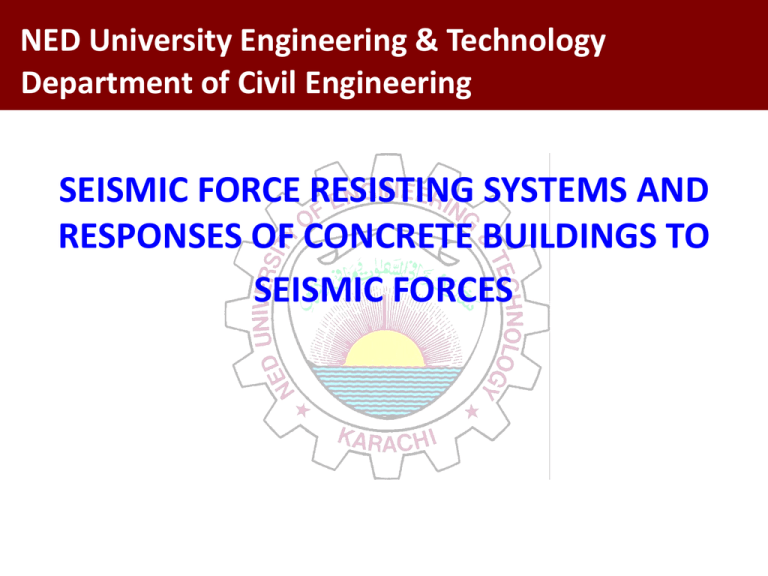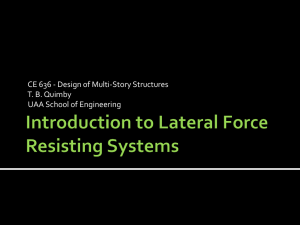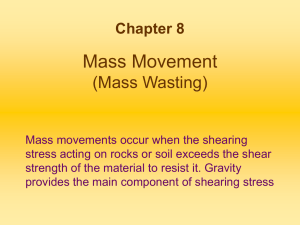I SFR Systems and Response
advertisement

NED University Engineering & Technology Department of Civil Engineering SEISMIC FORCE RESISTING SYSTEMS AND RESPONSES OF CONCRETE BUILDINGS TO SEISMIC FORCES NED University Engineering & Technology Department of Civil Engineering TOPICS COVERED Seismic Force Resisting Systems Building Configuration Response of Concrete Buildings NED University Engineering & Technology Department of Civil Engineering SEISMIC FORCE RESISTING SYSTEMS Basic structure systems that may be used to resist earthquake forces include Moment-Resisting Frame Systems Bearing Wall Systems Dual System Building Frame System Inverted Pendulum System NED University Engineering & Technology Department of Civil Engineering MOMENT-RESISTING FRAME SYSTEMS A structural system with complete space frame for gravity loads Lateral forces are resisted by flexural action of frame members Entire space frame or portion may be designated as seismic-force-resisting system Three types of detailing of frames are possible based on the effects of seismic forces Ordinary RC frames Intermediate moment frames Special moment frames NED University Engineering & Technology Department of Civil Engineering BEARING WALL SYSTEMS A structural system without complete space frame for gravity loads Bearing walls provide support for gravity loads Lateral loads are also resisted by the bearing walls acting as shear walls Two types of detailing of walls are possible based on the effects of seismic forces Ordinary RC shear walls Special RC shear walls NED University Engineering & Technology Department of Civil Engineering DUAL SYSTEMS A structural system with the following features Complete space frame for gravity loads 25% base shear resisted by space frames Resistance to lateral force is provided by the shear walls Moment frames are either special or intermediate frames Different combinations of shear walls are possible including Ordinary RC shear walls Special RC shear walls NED University Engineering & Technology Department of Civil Engineering BUILDING FRAME SYSTEMS A structural system without complete space frame for gravity loads Lateral loads are resisted by the shear walls No interaction between the shear wall and frames is considered in the lateral load analysis Two types of detailing of walls are possible based on the effects of seismic forces and building height Ordinary RC shear walls Special RC shear walls NED University Engineering & Technology Department of Civil Engineering INVERT PENDULUM SYSTEMS Structures that have a large portion of mass concentrated near the top Essentially one degree of freedom Little redundancy and overstrength Inelastic behaviour concentrated at the base Less energy dissipation capacity than other systems NED University Engineering & Technology Department of Civil Engineering BUILDING CONFIGURATION Buildings having irregular configurations in plan and/or elevation suffered greater damage Inelastic behaviour concentrates in certain localized regions in irregular structure Structural elements deteriorate rapidly in these areas Inelastic demand tend to be well distributed throughout a regular structure Elastic analysis methods are not capable to accurately predict distribution of seismic demand in an irregular structure Building with regular configuration are encouraged and highly irregular buildings are prohibited on sites close to active faults NED University Engineering & Technology Department of Civil Engineering PLAN IRREGULARITIES Five different plan irregularities have been identified Torsional irregularity Re-entrant corners Diaphragm discontinuity Out-of-plan offsets Nonparallel systems NED University Engineering & Technology Department of Civil Engineering PLAN IRREGULARITIES Torsional irregularity NED University Engineering & Technology Department of Civil Engineering PLAN IRREGULARITIES Re-entrant corners NED University Engineering & Technology Department of Civil Engineering PLAN IRREGULARITIES Diaphragm discontinuity NED University Engineering & Technology Department of Civil Engineering PLAN IRREGULARITIES Out-of-plan offsets NED University Engineering & Technology Department of Civil Engineering PLAN IRREGULARITIES Nonparallel systems NED University Engineering & Technology Department of Civil Engineering VERTICAL IRREGULARITIES Five different vertical structural irregularities have been identified Stiffness irregularity-soft story Weight (mass) irregularity Vertical geometric irregularity In-plane discontinuity in vertical lateral-force-resisting elements Discontinuity in capacity-weak story NED University Engineering & Technology Department of Civil Engineering VERTICAL IRREGULARITIES Stiffness irregularity-soft story NED University Engineering & Technology Department of Civil Engineering VERTICAL IRREGULARITIES Weight (mass) irregularity NED University Engineering & Technology Department of Civil Engineering VERTICAL IRREGULARITIES Vertical geometric irregularity NED University Engineering & Technology Department of Civil Engineering VERTICAL IRREGULARITIES In-plane discontinuity in vertical lateral-force-resisting elements NED University Engineering & Technology Department of Civil Engineering VERTICAL IRREGULARITIES Discontinuity in capacity-weak story NED University Engineering & Technology Department of Civil Engineering RESPONSE OF CONCRETE BUILDINGS A reliable load path is necessary to transfer lateral forces to the foundation Earthquake forces are resisted by either walls or frame elements Foundation components transfer the force to the earth Key elements of the load path through the structure include Diaphragm Walls Frames Foundations Connections are also important components of the chain Resistance of building is as strong as the weakest link in the path NED University Engineering & Technology Department of Civil Engineering DIAPHRAGM RESPONSE Diaphragms typically span between shear walls of concrete Respond like deep beams bending in their own plane under lateral forces Forces produced at the diaphragm edge include Shear Tension or compression Seismic forces acting perpendicular to the long side produce shear forces acting in the opposite direction Shear forces are transferred to the shear walls Tension develops in the chord and compression develops on the side on which seismic forces act NED University Engineering & Technology Department of Civil Engineering DIAPHRAGM RESPONSE Forces similar to chord forces also develop around openings Openings may need to be reinforced with additional longitudinal steel Shear forces at the diaphragm edge are transferred through shear-friction Another mechanism of shear transfer is dowel action The assumption here is that reinforcement acts as anchor bolt in shear NED University Engineering & Technology Department of Civil Engineering SEISMIC RESPONSE OF SHEAR WALLS Shear walls resist gravity loads and in-plane lateral forces They are like vertical cantilever deep beams Shear force from diaphragm causes bending moment and shear force in the plane of the wall Tendency to overturn and slide is resisted by the foundation Bending moment increases from top to bottom of a building and causes tension and compression forces in the wall plane Seismic response of short stocky shear wall is governed by shear Response of taller walls is governed by flexure NED University Engineering & Technology Department of Civil Engineering SEISMIC RESPONSE OF SHEAR WALLS For walls with H/L between 1-2 response depends on several factors including amount of shear reinforcing Shear dominated response is characterized by inclined (x-shaped) cracking pattern The wall can loose strength rapidly with little warning NED University Engineering & Technology Department of Civil Engineering SEISMIC RESPONSE OF FRAMES Response of frames is different than shear walls to lateral forces Frame resists by being deformed by lateral forces due to the rigidity of the beam-column joints Beams and columns bend due to this rigidity Tension stresses caused by the bending must be resisted by the reinforcement Bending also causes vertical shear forces in beams and horizontal shear forces in columns Vertical shear reinforcement is needed in beams and horizontal shear reinforcement in columns NED University Engineering & Technology Department of Civil Engineering FOUNDATION RESPONSE Foundations can be shallow or deep Shallow foundations are supported by vertical pressure of earth Foundation types include Square or rectangular spread footings Continuous strip footings Deep foundations consists of piles made of Wood Steel Concrete Piles can be poured in place or driven piles NED University Engineering & Technology Department of Civil Engineering FOUNDATION RESPONSE Piles are supported by end bearing and skin friction Connected together by ties, grade beams or slabs on grade Shear forces are transferred from walls and frames to the foundation Dowels in foundation must match the vertical reinforcement in walls and frames NED University Engineering & Technology Department of Civil Engineering THANK YOU FOR YOUR ATTENTION !







